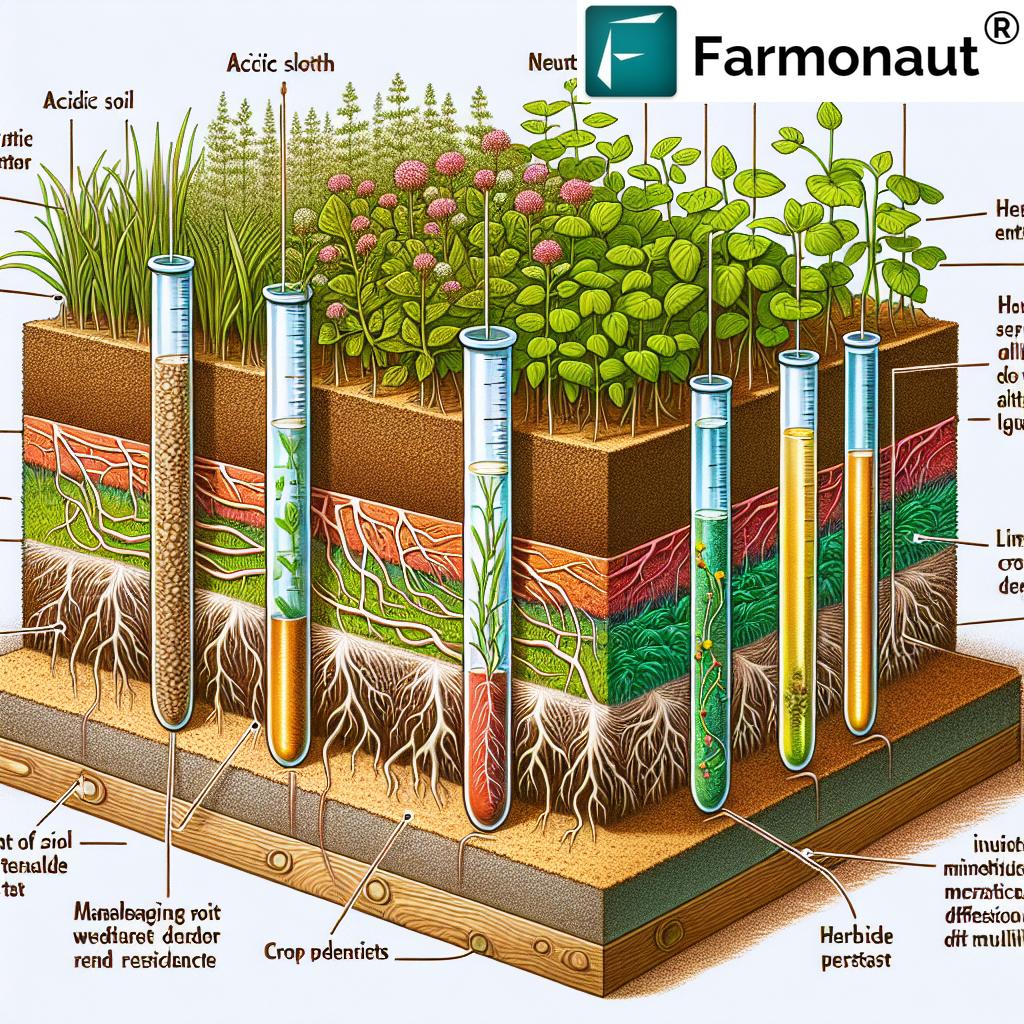ph water for weed: 7 Proven Ways Soil pH Boosts Crop Yields
“A soil pH between 6.0 and 7.0 can increase crop yields by up to 20% compared to acidic soils.”
Introduction: The Vital Role of Soil pH in Agriculture
As practitioners in sustainable agriculture, we recognize that soil pH is not simply a number on a test report; it is a fundamental property influencing every aspect of crop performance, from seedling emergence to final yield. The relationship between soil pH and weed control is particularly crucial for effective farm management, optimal herbicide efficacy, and the realization of sustainable farming outcomes.
In this blog, we will explore how managing soil pH can unlock higher yields, suppress weeds, increase the effectiveness of herbicides, and bolster long-term productivity. We will also share practical, research-backed weed management strategies, and show how modern tools such as Farmonaut’s precision platform can make advanced soil and crop management accessible for farmers globally.
Let’s embark on a journey through the chemistry, biology, and practical realities of acidic, neutral, and alkaline soils—and discover why managing soil pH is your farm’s most powerful lever for growth.
Understanding Soil pH: The Science and the Scale
Soil pH is a measure of the soil’s hydrogen ion concentration, determined on a scale from 0 to 14—with 7 being neutral, values below 7 indicating increasing acidity, and values above 7 indicating alkalinity. Most agricultural soils fall within the pH range of 4 to 8. This property fundamentally affects nutrient availability, microbial activity, and the chemical reactions that drive plant health (see also: IntechOpen).
- Acidic Soils (pH < 7): Can cause deficiencies in nutrients like phosphorus and make toxic elements (aluminum, manganese) more soluble—potentially harming plant roots, suppressing growth, and allowing weeds to thrive.
- Neutral Soils (pH ≈ 7): Feature optimal nutrient solubility, maximum microbial activity, and best root development.
- Alkaline Soils (pH > 7): Can lead to micronutrient deficiencies (especially iron, zinc) and impact the efficacy and persistence of certain herbicides.
It’s this dynamic balance that makes managing soil pH a foundational practice in sustainable agriculture.
“Optimal soil pH improves herbicide effectiveness by 30%, leading to better weed control and sustainable farming outcomes.”
Why pH Matters: 7 Proven Ways Soil pH Boosts Crop Yields
Understanding and managing soil pH in agriculture directly translates into better crop yields, stronger plant growth, and lower weed pressure. Below, we detail seven ways in which optimal pH—achieved through approaches like liming acidic soils and regularly monitoring pH—serves as a powerful tool for productive and sustainable farming.
-
Enhancing Nutrient Availability
Soil pH and nutrient availability: At pH 6.0–7.5, essential nutrients such as phosphorus, nitrogen, potassium, calcium, and magnesium become more soluble and are readily absorbed by crop roots. In acidic soils (pH <6), phosphorus often binds with iron and aluminum, becoming less available, while alkaline soils (pH > 7.5) can limit availability of micronutrients like iron and zinc. This balance is critical for the development and production of crops such as wheat, corn, and rice. -
Stimulating Microbial Activity
Beneficial microbes responsible for mineralizing organic matter and fixing atmospheric nitrogen thrive best in neutral soils. Higher microbial activity translates to better breakdown of organic residues, faster conversion of nutrients, and improved soil structure. In acidic or strongly alkaline soils, biological activity is often hampered, compromising nutrient cycling and making plants more susceptible to disease and weed infestation. -
Improving Herbicide Efficacy and Persistence
The effect of soil pH on herbicide efficacy is widely documented. For example, triazine compounds like atrazine degrade slowly in alkaline soils, providing longer-lasting weed control, but can also raise carryover risk. In acidic soils, imidazolinone herbicides persist longer, which is beneficial but requires careful crop rotation planning. Managing pH supports optimal weed management strategies and safer herbicide use. -
Boosting Plant Root Development
High acidity or alkalinity can cause root stunting, nutrient deficiency symptoms, or toxicity (such as from aluminum or manganese in low-pH soils). A balanced pH ensures robust root growth, maximizing plant access to water and nutrients while supporting competition against weeds. -
Reducing Weed Populations
Soil pH and weed control: Some weed species have adapted to thrive in acids soils, dominating fields with low pH. Research (IntechOpen) finds up to 80% higher weed populations in unlimed, acidic soils compared to limed, near-neutral soils. By adjusting pH, we can make environments less favorable for many aggressive weed species, tilting the advantage toward the crop. -
Increasing Crop Competitiveness and Yield
All the above factors combine to make crops more competitive against weeds and environmental stresses. In controlled studies, liming acidic soils and optimizing pH have consistently resulted in yield increases of up to 20% in major crops (see: trivia banners). This is due to direct effects on nutrient uptake, root growth, and weed suppression. -
Improving Sustainability and Soil Health
Managing soil pH is a pillar of sustainable farming practices. It reduces the need for excessive fertilizer or herbicide inputs, promotes healthy soil biology, and ensures long-term productivity for future generations.
Soil pH and Weed Proliferation
It’s important for us to recognize that weed species, like our cultivated crops and other plants, have distinct pH preferences. Some weeds thrive in acidic soils (for example, sheep’s sorrel, wild radish), while others prefer neutral or alkaline conditions.
In a major research study, winter wheat plots unlimed (pH 4.1–4.3) had almost 80% higher weed populations than limed plots corrected to pH 5.8–6.0. Why is this so?
- Acidic soils hinder many crop species, causing stress, yellowing, and suppressed growth—while some local weeds flourish in these same conditions.
- Liming acidic soils not only improves crop growth directly, but also makes the “soil neighborhood” less desirable for troublesome weeds—supporting more effective weed management strategies and sustainable yield gains.
The upshot: Simply increasing soil pH towards neutral can tilt the field away from weeds, and toward your crops.
Soil pH Impact Matrix: Yields, Weeds, Herbicides & Sustainability
Table Notes: Yield %, weed levels, and herbicide efficacy are research-based estimates and can vary by crop species, location, and climate. Targeting a pH of 6.0–7.2 ensures most crops achieve best performance with manageable weeds.
Effect of Soil pH on Herbicide Efficacy
A critical yet often-overlooked aspect of soil pH management is how it affects the chemical stability and breakdown of herbicides in soils. This has serious implications for both weed control and environmental safety.
- Triazine Herbicides (Atrazine, Simazine): More persistent in alkaline soils (pH > 7). They degrade slower, increasing residual activity (good for weed control), but also raise risks of carryover affecting subsequent crops (Oklahoma State Extension).
- Sulfonylurea Herbicides (Chlorsulfuron, Metsulfuron): Similarly more persistent with high pH but can cause damage to next year’s sensitive plantings. Monitoring pH is necessary for effective herbicide use and rotation planning.
- Imidazolinone Herbicides (Imazamox, Imazapic): Persist longer in acidic soils (pH < 6). While this gives more weed control initially, it may damage future crops unless carryover issues are managed.
We must remember that herbicide persistence in soils not only determines weed control success, but also risks of residue, leaching, and negative effects on crops that follow. Always calibrate herbicides for your local pH conditions and test soils routinely to adapt application rates responsibly.
- Practical Tip: Check the labels of herbicides for pH sensitivity, and use digital mapping tools like Farmonaut to track pH and make informed herbicide choices for each field.
Managing Soil pH in Agriculture: Strategies and Solutions
Now that we understand how optimizing pH boosts crop yield and soil health, the question becomes: How can we effectively manage pH on our farms?
1. Soil Testing and Monitoring
The first step in any soil pH management strategy is regular soil testing. Routine monitoring allows us to:
- Detect trends in acidity or alkalinity early, before visible crop symptoms appear.
- Make data-driven decisions about lime (for acidic soils) or elemental sulfur (for alkaline soils) applications.
Use Farmonaut’s satellite-based monitoring to spot areas of nutrient stress and variability.
2. Liming Acidic Soils
Application of agricultural lime (calcium carbonate) is the primary way to raise soil pH and move acidic soils back toward neutral. Research shows that liming can:
- Reduce weed populations dramatically (wild radish, ryegrass, barley grass); some populations dropped by up to 70% within four years of consistent liming (Weed Science Society of America).
- Increase yields in crops like corn, wheat, and alfalfa, especially in soils with naturally low pH.
3. Managing Alkaline Soils
For high-pH soils, we can:
- Apply sulfur-based amendments or acid-forming fertilizers to lower soil pH slightly.
- Manage micronutrient deficiencies (like iron, zinc) with foliar sprays or chelated products.
4. Crop Rotation and Cover Cropping
Rotation with acid-tolerant crops or use of cover crops that add organic matter will help buffer pH changes and support microbial activity. Leguminous covers also fix nitrogen, enhancing nutrient availability under challenging pH conditions.
5. Precision Application and Variable-Rate Technology
Patchy soil pH is common, especially in large fields. Farmonaut’s Large Scale Farm Management solution (see details) uses satellite insights to map your fields and guide variable-rate lime or fertilizer placement. This technology saves resources and guarantees each area receives the correct amendment.
6. Data-Driven Decision Support
Our team recommends integrating data platforms like Farmonaut’s Jeevn AI Advisory System to combine pH data, weather, and crop health insights for targeted pH management. For larger operations, API access and developer docs enable connection of soil and weather sensors with remote monitoring for actionable alerts.
7. Sustainability and Digital Traceability
Optimizing pH is about more than yields; it is about sustainable stewardship. With Farmonaut’s carbon footprinting tools, you can ensure that your management practices not only boost productivity, but also reduce your environmental impact, enhancing soil health, water retention, and greenhouse gas reduction.
Plus, with blockchain-based traceability solutions, transparency on your pH management and input use is possible right up to the consumer—building trust and value for your harvest.
Leveraging Digital Tools: Farmonaut for Soil and Crop Management
Advancements in agricultural technology have made precision farming accessible to all farm sizes. Farmonaut stands at the forefront with a platform offering:
- Satellite-based soil and vegetation health monitoring: Track NDVI (crop vigor), soil moisture levels, and identify nutrient imbalances or pH-induced stress.
- AI-powered crop management advisory: Farmonaut’s Jeevn AI Advisory provides real-time insights on pH management, weather, and disease risk.
- Resource and fleet management: Optimize input use (lime, fertilizer, herbicide), reduce costs, and improve sustainability with fleet/resource management tools.
- Blockchain traceability: Our traceability solutions help you prove sustainable input use and management, from seed to consumer.
- Environmental monitoring: Use carbon footprint tracking to document and reduce your farm’s emissions as you optimize pH.
- Accessibility for all: Available via Web, Android, iOS and API.
Already managing a large farming operation or an agribusiness? Ask about our Large Scale Farm Management solution or satellite-based crop insurance verification to cut risk and improve profitability.
Conclusion: Optimizing Soil pH for Sustainable Yields
To sum up, soil pH is one of the most influential factors for crop productivity, weed suppression, and herbicide effectiveness. The relationship between soil pH and weed control is a gateway to stronger, more sustainable, and profitable farming. By adopting practices such as regular monitoring, liming acidic soils, targeted amendments, and harnessing precision digital solutions, we safeguard our farm’s future.
Let’s continue to champion the science of soil—for our crops, our environment, and the generations that follow.
Farmonaut Subscription
FAQ: Soil pH and Weed Control
What is the optimal soil pH for crops?
For most crops, the optimal soil pH is between 6.0 and 7.5. This range maximizes nutrient solubility, microbial activity, and overall crop yield.
How does soil pH affect weed growth?
Certain weed species thrive in acidic or alkaline soils, and may outcompete crops in those conditions. Managing pH (for example, through liming acidic soils) helps suppress unwanted weeds and supports healthier crops.
How does soil pH influence herbicide performance?
Soil pH can change the persistence and breakdown rate of herbicides. Some, like triazines, last longer in alkaline soils, raising carryover risks, while others like imidazolinones persist in acidic soils. Always match herbicide type to your soil’s pH and rotate as needed.
How frequently should we test soil pH?
Annual soil testing (preferably in the same season each year) is recommended for optimal crop management and timely amendments.
How does Farmonaut help manage soil pH?
Farmonaut provides satellite-based crop and soil monitoring, AI-driven advisory, and detailed resource management solutions to help you track, plan, and optimize pH management—leading to better yields and long-term sustainability.


















